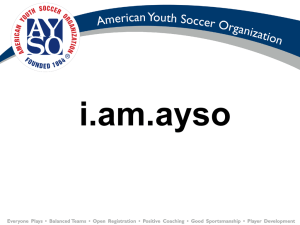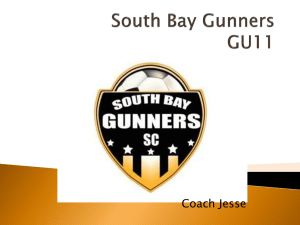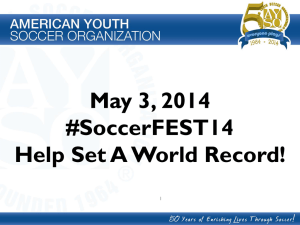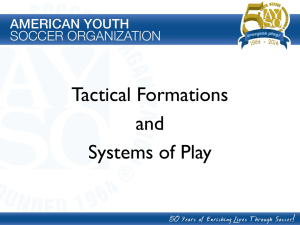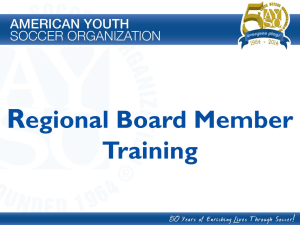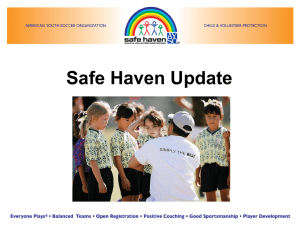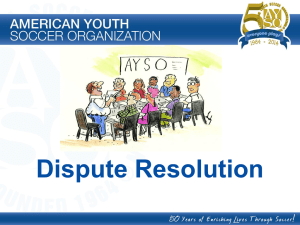Safety Director Lesson Plan
advertisement
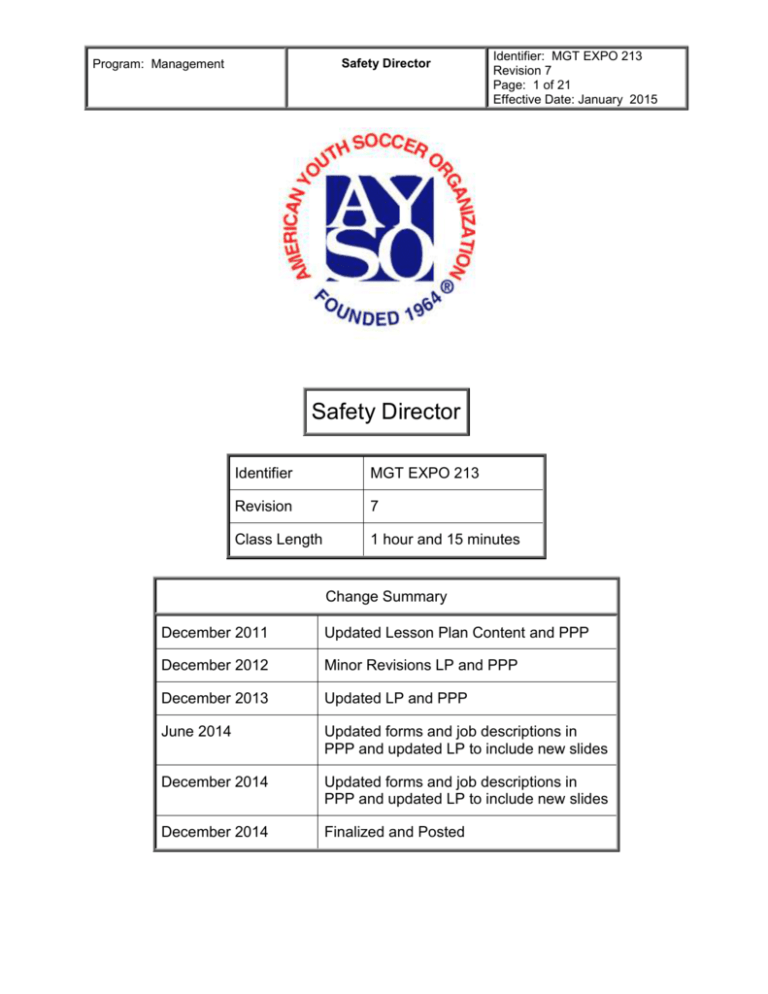
Safety Director Program: Management Identifier: MGT EXPO 213 Revision 7 Page: 1 of 21 Effective Date: January 2015 Safety Director Identifier MGT EXPO 213 Revision 7 Class Length 1 hour and 15 minutes Change Summary December 2011 Updated Lesson Plan Content and PPP December 2012 Minor Revisions LP and PPP December 2013 Updated LP and PPP June 2014 Updated forms and job descriptions in PPP and updated LP to include new slides December 2014 Updated forms and job descriptions in PPP and updated LP to include new slides December 2014 Finalized and Posted Program: Management Safety Director Identifier: MGT EXPO 213 Revision 7 Page: 2 of 21 Effective Date: January 2015 1. Lesson Plan Goals To train volunteers to serve as Safety Directors in their Regions, in accordance with the position description, policies, procedures, and guidelines of AYSO as they relate to this position. 2. Class Length 1 hour and 15 minutes (save time for questions and answers) 3. Instructor Requirements Management Instructor Advanced Management Instructor at AYSO EXPOs 4. Learning Objectives To understand the importance of the Safety Director in the operation of the Region. To understand the Safety Director’s position description, and the importance of following it. To review the knowledge a Safety Director must have. To discuss how to apply knowledge and implement Regional Risk Management properly. To understand that this workshop is the training component and certification can be obtained in the AYSO’s Safe Haven® workshop. 5. Prerequisites None 6. Materials Workshop Roster AYSO Safety Director Manual to show Power Point Presentation - PPP Safety Director Information Documents/Forms to show (not provided at EXPOs) 7. Equipment Lesson Plan PowerPoint Presentation Laptop Computer LCD Projector Flip Chart (if available) Markers Tape Program: Management Safety Director Identifier: MGT EXPO 213 Revision 7 Page: 3 of 21 Effective Date: January 2015 8. Special Instructor Notes Instructor Notes are in Italics These are the icons that will be used throughout the lesson: Activity Key (Critical) Point Question Instructor Note Handout PowerPoint Nuts and Bolts Time - Halfway 9. General Instructor Notes To be credited for this training, attendees must sign the roster legibly. Leave 5-10 minutes at the end of the class to answer any questions from attendees. Always assess the attendees to make sure that it is understood that this workshop is for new, first year Safety Directors, and that what you will be covering will be basic information. Small Group Instruction (Under 50 attendees) - If giving this workshop at the Regional or Area level, a much more informal approach can be taken) For smaller classes, set up room in classroom style. Instruct attendees to answer the question on the slide (questions or concerns). At the end of the lesson, address any questions or concerns that were not addressed during the course of the lesson. If possible a small giveaway such as an “It’s for the kids” pin or soccer ball key chain or small candy can be a reward to any Safety Director who gives a solution or helpful hint for another volunteer’s problem or for the winning team in the Risk Management game. For small groups, if possible, offer to send out to all attendees a list of who was in attendance. You will be setting up a system to make it easier for them to communicate with each other. If there is one attendee who is a role model or leader in this group, ask if he/she will act as a mentor to new attendees who are appointed to this position, or for any of the attendees in the workshop. End the workshop by giving a list of people who can be called with technical questions. This could be the Area Director, Section Director or National Office staff. AYSO EXPOs Follow the same guidelines for small group instruction, with the following exception: Program: Management Safety Director Identifier: MGT EXPO 213 Revision 7 Page: 4 of 21 Effective Date: January 2015 Ask attendees to write down their questions or concerns on a piece of paper and ask attendees to put these questions aside. At the end of the lesson, ask attendees to pull out the questions they wrote down earlier and to check whether their questions or concerns were answered during the course of the lesson. If questions still remain, take time to address these remaining issues. At AYSO EXPOs, please use the PPP provided with the lesson plan. 10. Introduction (5 minutes) Slide 1 While attendees come into room, have PPP Slide 1 on screen Opening slide; share screen with audience using SHOW SCREEN. Be sure to start on time… Welcome attendees to Safety Director Training Workshop by introducing yourself as workshop leader, your topic, and your co-instructors (if any). Slide 2 Course Credit Explain the Course Roster Slide; Make sure all attendees have signed the roster LEGIBLY with their LEGAL first and last names; address, home phone number and birth date. Birth date is one of the fields used to ensure that course credit is given to the correct person; i.e. “John Smith, Los Angeles, CA” Begin passing out the roster as attendees enter the room. Remember to check at the end of the workshop that everyone has signed it. For larger groups you may need 2-3 rosters or even more. Explain the meaning of S/A/R for the people who don’t know. Remind your attendees that AYSO provides training, certification, and continuing education in its Safe Haven Program to protect its players and volunteers. This course is the job training component and AYSO’s Safe Haven® course is the certification component. Slide 3 Learning Objectives Understand the role and responsibilities of the Regional Safety Director. Review the resources available to help a Safety Director be successful. Cover the key components of Regional Safety and Risk Management. Remind attendees that supplementary information documents and forms are included on www.ayso.org. (At the Regional and Area level, the instructor is responsible for providing a copy of all the handouts to the attendees.) • Safety Director Training Objectives • CLICK for first item. • STATE: “We will be explaining the key responsibilities of the Safety Director function.” (Role) Program: Management • • • • Safety Director Identifier: MGT EXPO 213 Revision 7 Page: 5 of 21 Effective Date: January 2015 nd CLICK for 2 item. “It would be impossible to remember everything covered in this session or to cover every aspect of the Safety Director’s job, so we want to make sure you know about all the resources available to make this very important job easier.” CLICK for last item. STATE: “We will discuss some of the key components of Regional Safety” (Information) CLICK to move to next slide. 11. Body (Lesson Procedure) Slide 4 But First … The Mission of AYSO is “To develop and deliver quality youth soccer programs which promote a fun, family environment based on our philosophies.” Make the first click on the slide and ask if anyone knows what the Mission Statement of AYSO is, then make the second click showing the Mission. Slide 5 AYSO Philosophies Ask the attendees to honestly tell you how many of them know the six philosophies. AYSO is defined by its philosophies and every Regional Board Member should know them. • • • • • • Everyone Plays® Balanced Teams Open Registration Positive Coaching Good Sportsmanship Player Development • CLICK to five times to display each of the first 5 philosophies; • CLICK to show “Can everyone name the 6th Philosophy?” • CLICK to reveal “Player Development” • CLICK for key message “AYSO prides itself on striving to create a safe, fair, fun and positive environment in which all children and their families can enjoy the game of soccer.” • CLICK to advance the slide Slide 6 Volunteer Protection For protection under the Volunteer Protection Act and other laws, AYSO requires all volunteers to: • Submit and eSign a Volunteer Application every year, • Be authorized to do their job by the Region, Area, Section or National Board of Directors, • Act within the scope of their Job Descriptions and AYSO’s policies, procedures and guidelines, • Complete AYSO’s Safe Haven and be trained for their jobs. Program: Management Safety Director Identifier: MGT EXPO 213 Revision 7 Page: 6 of 21 Effective Date: January 2015 Every volunteer must complete and eSign a volunteer application each and every year in order to be currently registered with AYSO and to consent to a required annual background check. To be authorized to perform their duties, they must be appointed to the position and approved by the Board then the RC will give them permission and rights in eAYSO. Safe Haven only has to be taken once*. It is recommended that all Safety Directors and ® Board Members take the new AYSO’s Safe Haven . * If a volunteer took BASIC, Safe Haven for Referee or Safe Haven for Coaches and decides to volunteer for another discipline, they must take the new AYSO’s Safe Haven. Slide 7 Group Activity Divide into three groups This activity will work for groups of under 20. For larger groups, dividing up into three groups may be difficult. You may have to do this as a guided participation exercise. In your groups select: One person to write down answers One person to be the group’s spokesperson All groups will have five minutes to brainstorm answers to their assigned question As we review the questions, each group will then have the opportunity to share their answers with the class. These answers should not be looked up in case someone has the Safety Director Manual. Have them guess using common sense. This is a rapid response exercise! Give them 5 minutes to brainstorm and 5 minutes to toss out ideas. Slide 8 Group Assignments Group # 1: Why does the Region need a Safety Director? Group #2: What are the responsibilities and duties of a Safety Director? Group #3: Why should a Safety Director communicate with other Board Members? Ask attendees to give the answer that comes to mind first. If attendees have their Safety Director Manual with them, please ask that they keep the manual closed. Have the Safety Director Manual handy so that you can check answers. For this first question, you will receive subjective comments. Accept all answers if possible. If you are doing this through guided participation, make sure to get input from as many attendees as possible. Leave this slide up during the exercise. Group # 3 These are some Regional Board Positions Program: Management Safety Director Identifier: MGT EXPO 213 Revision 7 Page: 7 of 21 Effective Date: January 2015 Regional Commissioner (RC) Child and Volunteer Protection Advocate (CVPA) Treasurer Registrar Referees and Coaches Equipment and Field Coordinator What communication would occur between these positions and the Safety Director? Accept any answers that make sense. This is a brainstorming exercise. RC – getting all the Regional Board Members to be available at games to fill out the incident report if needed. CVPA – any volunteers that you have delegated tasks to should fill out the Volunteer Application. Treasurer – ask to budget money to secure goalposts, repair fields, provide first aid kits and training. Registrar – ask to set up a table at Registration to display safety procedures, and pass out SAI forms. Referees and Coaches – go over safety issues and procedures with them. Equipment and Field Coordinator – check and double check safety issues for equipment and field inspection. Slide 9 Safety Director The Safety Director serves as the Region focal point for safety awareness and insurance information. The Safety Director position covers a variety of safety concerns. AYSO does the research and the Safety Director is the local expert in each of these areas of safety concern: first aid, insurance coverage, weather advisements and safety Inspection. Many other volunteers share in the responsibility to execute the Region’s safety plan and ensure a safe, family-friendly environment for youth soccer. Slide 10 Responsibilities Act as the Regional focal point for AYSO insurance information and safety awareness. Implement a Regional Safety Plan which includes: First aid kits Field and equipment inspections Injury prevention Procedures for environmental hazards The Safety Director is the contact person for each of these main safety focuses. Program: Management Safety Director Identifier: MGT EXPO 213 Revision 7 Page: 8 of 21 Effective Date: January 2015 Slide 11 Responsibilities Ensure the Region complies with AYSO Incident and Concussion Reporting and Emergency Treatment Authorization. Ensure the availability of Soccer Accident Insurance brochures and claim forms. Be familiar with the SAI claim process and Incident Report forms. www.ayso.org For Volunteers > Safety Director > Forms & Documents > Insurance The Safety Director position covers a variety of safety concerns. •The Player Registration Form contains the Emergency Treatment Authorization language needed to seek treatment for a child in an emergency when the parents are not present. Coaches are required by the National Rules & Regulations to keep a signed copy of each player’s Registration Forms in their possession at all times during AYSO activities. Report any loss or theft of these forms to the National Safe Haven Office. •Safety Directors’ are asked to confirm that AYSO’s Player Registration Form’s Emergency Treatment Authorization will be accepted by local emergency treatment facilities. •All registered attendees are eligible for Soccer Accident Insurance. Brochures and claims forms must be available to anyone who suffers an injury. Slide 12 AYSO Incident Report • • AYSO Incident Reports are designed to capture all the facts and contact information whenever there is an incident. The Safety Director should prepare Regional Board Members to assist volunteers with completion of the AYSO Incident Reports. Click to advance slide to show the events requiring an Incident Report. Slide 13 Quiz Time True or False? An AYSO Incident Report is only required in the event of an injury. Click to show the answer is “False” Click to slide explaining Incident Reports Slide 14 AYSO Incident Report An Incident Report is required whenever there is an incident involving AYSO attendees, activities, facilities, or property including: • Injuries, Concussions • Illness requiring medical treatment • Threats • Fighting • Acts of Violence Program: Management • • • • • Safety Director Identifier: MGT EXPO 213 Revision 7 Page: 9 of 21 Effective Date: January 2015 Property Damage Hospitalizations Calls to Law Enforcement Attendee arrests Lawsuits An Incident Report should be completed any time there is an “incident” in order to record potential witness statements, contact information for further communication, facts for review panels and consideration for any disciplinary actions. Slide 15 An AYSO Incident Report • • • Download Incident Report Form from www.ayso.org. Notify the National Office immediately of any incident involving theft, fraud, property damage, arrests, law enforcement or lawsuits. Send a copy of all AYSO Incident Reports to: RiskManagement@ayso.org. The Safety Director is responsible for collecting Incident Reports and forwarding copies to the National Office at insurance@ayso.org. • Click to bring up an Incident Report Form. • Let attendees know the instructions are included on the back side of the form; additional documentation can be attached. Slide 16 Emergency Treatment Authorization Coaches MUST have a signed copy of the Player Registration Forms and any additional Emergency Authorization forms required locally with them at all times during practices and games in the event of medical emergency. This form contains the Emergency Authorization. Regions should not accept any Player Registration Form or Volunteer Application with crossed-out words or changes to any of the language on the forms. These forms should be considered contracts between te participants and the Region and the AYSO Organization. Slide 17 Participation Release Form Should be given to parent/guardian of any player suffering an illness/injury requiring a Doctor/ER visit. Must be completed by parent/guardian before player returns to play. The Participation Release Form asks parents to confirm the player is cleared to play and that a medical release has been obtained when required for a possible concussion. All forms should be given to Safety Director for storage with Region files and forwarded to the National Office. RiskManagement@ayso.org Program: Management Safety Director Identifier: MGT EXPO 213 Revision 7 Page: 10 of 21 Effective Date: January 2015 Click three times for all information to appear. Slide 18 Concussions • • • • Can occur when a blow to the head or body causes rapid movement of the brain inside the skull. May be result of fall, head-to-head collision, striking the goalpost/ball or even a mild bump/blow. Can occur without loss of consciousness. Are serious brain injuries that can cause death. Slide 19 Concussions See the Region Toolkit for AYSO/CDC concussion materials. Slide 20 Concussions AYSO/CDC Parent/Player Information Sheets • Should be signed by players and parents, kept with Player Registration Forms and are now included in the eAYSO Player Registration eSign process. • Required by many states. Slide 21 Concussions AYSO/CDC Coach/Referee Action Plan • Should be given to all coaches/referees. • Details the steps to take in the event of a possible concussion. The Coach and Referee Action Plan includes the Signs and Symptoms of a possible concussion as well as the steps Coaches and Referees should take if a player is observed to have a sign/symptom of a possible concussion. Slide 22 Concussions When a player is removed from play for a possible concussion, coaches are instructed to give the parents: • a Concussion Information Sheet, • a Participation Release Form, • SAI Brochure/Claim Form and Program: Management • Safety Director Identifier: MGT EXPO 213 Revision 7 Page: 11 of 21 Effective Date: January 2015 a copy of the Incident Report. Slide 23 Concussions On return to play, the coach must obtain a signed Participation Release, and any required Medical Release. The coach submits a copy of signed Player Registration Form, Participation Release, Medical Release and the Incident Report to the Safety Director. Slide 24 Concussions The Safety Director must submit the signed copies of the: -Player Registration Form, -Concussion Info Sheet -Participation Release, -Medical clearance, -Incident Report, and -any SAI Claim forms to RiskManagement@ayso.org. Slide 25 Regional Safety Plan What should be included in a Regional Safety Plan? Ask the attendees what items they think should be covered in a Regional Safety Plan? Use Guided Participation to lead them to topics if they become stuck. Ask about Equipment (then what equipment to get to goalposts, bleachers, etc.), (Click to show example items on screen) Fields, and Weather conditions. Ask attendees if they know what the single greatest safety concern is? Answer: Goalposts Click to advance slide to further discuss risks goalposts present. Slide 26 Goalpost Safety Check the Safety Director resources on www.ayso.org for a link to this CBS news video about Goalpost Safety. (This video) says it all… Goalposts are the single most important safety issue for any Region. This issue is the single most important safety issue for any Region. Remember that goalpost safety is critical especially when games are not in play. A procedure is needed for how to store portable goals when not in use. Every year someone dies and several are critically injured by goalposts. When purchasing new goals for the Region, look for Tip-Resistant goals. Slide 27 Goalpost Safety Program: Management Safety Director Identifier: MGT EXPO 213 Revision 7 Page: 12 of 21 Effective Date: January 2015 The Safety Director Manual and www.ayso.org includes a copy of the Consumer Product Safety Commission’s Guidelines for soccer goal safety. Goals must be anchored when in use and stored safely when not used. Aside from the obvious condition of the goals, all goals must be anchored when in use and stored safely when not used (chained face to face or chained to a fence so they cannot topple over). Slide 28 Goalpost Safety All goals should have warning labels! Contact Fold-A-Goal, 800-542-4625 or info@fold-a-goal.com for free labels No one should every climb on the goalposts or play with the nets. Slide 29 Goalpost Safety AYSO equipment, particularly goalposts, should only be used by AYSO programs and not shared or loaned. Slide 30 Field Inspection The Safety Director should work with Field Coordinators, referees and coaches to ensure fields are inspected for hazards: • Prior to the season start to correct permanent problems, • At the beginning of each game day to evaluate field conditions (taking into account weather) and • Before each game to remove hazards created by debris or foreign objects left behind. This responsibility is something that can be delegated to a volunteer who lives near a particular field. Click to ask, What is wrong with this picture? The touchline is drawn over a light post base – the light post is a hazard. Imagine what would happen if someone ran into it. Slide 31 Field Inspection Prior to the season start, fields should be evaluated and corrected as needed for: • Walls or fences too close to playing fields • Trees or plants protruding into field of play • Spectator seating too close to touchlines • Playing fields unprotected from traffic Program: Management • • Safety Director Identifier: MGT EXPO 213 Revision 7 Page: 13 of 21 Effective Date: January 2015 Field equipment from other sports Sprinklers, poor grass/surface area, holes Slide 32 Field Inspections Before each game day, fields should be evaluated for conditional hazards including: • Very dry/hard surfaces • Wet/slippery fields • Foreign objects such as rocks, broken glass, metal • Gopher holes, divots, bumps on the field Before each game, coaches, refs check for debris. Hazards/conditions to consider at the beginning of each game day and before each game. Slide 33 Field Inspections Look for checklists on www.ayso.org Goalpost safety and field inspection checklists are available on ayso.org in the Safety Director Forms & Documents section. These lists can be given to Field Coordinators and workers to help with the on-going inspection process. Slide 34 Severe Weather Be prepared for environmental hazards: • Hot weather – risk of dehydration/heat stroke • Severe cold weather - risk of hypothermia • Thunder and lightning • Tornado, hurricane, severe weather warnings • Wildfires The Regional Board should develop communication plans for these situations to ensure the safety of all attendees. See AYSO’s Safe Haven manual for more information Encourage the Regions to post their policy on their website and inform all coaches of the policy at the beginning of the playing season. Program: Management Safety Director Identifier: MGT EXPO 213 Revision 7 Page: 14 of 21 Effective Date: January 2015 Click to show call out window to remind Regions to development communications plans for letting attendees know when games/practices are cancelled for safety reasons. mudlines, phone trees are just a few tools. Slide 35 Severe Weather Thunder and Lightning When thunder is heard lightening is within striking distance, seek shelter immediately: • In a building (roof and four walls) • Inside a fully enclosed metal vehicle with windows up Restart games after no thunder has been heard for 30 minutes or an ALL CLEAR SIREN sounded. Slide 36 Severe Weather Hot Weather • Allow more frequent water breaks and substitutions. • Remind attendees of the importance of sunscreen and consider adding shade via tents. Schedule games during non-peak times, allow for rest between games or cancel if not safe. Slide 37 Severe Weather Cold Weather Rain, hail, snow and sleet can also cause field conditions to deteriorate rapidly, increasing risk of injury. Players should be permitted to wear extra garments under the jersey/shorts, and knit hats/ gloves, etc. No hoodies are permitted, they are a choking hazard. Slide 38 First Aid Kit A basic First Aid kit should be available to every team during practices and games. Kits can be provided: to each coach at the start of the season. in a standard location at all soccer fields used for practices and games. Kits should be inspected and re-stocked frequently See the Safety Director Manual for suggested contents Every coach and team must have access to a first aid kit during the season. This can be done by providing teams with first aid kits or keeping a well-stocked kit on the fields. Recommended First Aid Kit contents are included in the Safety Director and Safe Haven manuals. Kits must be re-stocked and inspected frequently. Kits may also be purchased in volume and from AYSO vendors. Slide 39 First Aid Program: Management Safety Director Identifier: MGT EXPO 213 Revision 7 Page: 15 of 21 Effective Date: January 2015 ® • Safety Director and Safe Haven Manuals provide brief descriptions of emergency medical conditions that may require immediate medical assistance. • Not intended to be a treatment guide or First Aid training. • Regions can offer first aid training if conducted by a certified professional. Remember, when in doubt, call 911. The manuals also include common soccer conditions and immediate first aid recommendations for things like blisters or a sprain. This information is not intended to be a treatment guide or to replace first aid training. It is simply an awareness tool. Slide 40 Question? What is the general reason for having insurance? Accept any reasonable response… The idea is to have attendees think about why AYSO carries insurance and what it generally provides so that the following informational slides have some context. Slide 41 General Liability Who/What is covered? The Region, AYSO, and currently registered volunteers for legal damages resulting from: • Participant and spectator injury • Activities necessary to the conduct of games or practices • Sponsored functions: meetings, banquets, fundraisers • Golf cart accidents when driven by a licensed adult and of age majority in your state, but not cart replacement. The Safety Director position covers a variety of safety concerns. Reminder: Never leave the keys in a golf cart or let minors play on or with golf carts. Slide 42 General Liability What is not covered? • The sale or detonation of fireworks • Amusement devices – specifically bounce houses, climbing walls and other carnivaltype rides • Player vs. Player lawsuits These types of Regional events are becoming more and more popular so understanding the legal implications is important. But what about opening day events and fundraisers? The owners and providers of amusements and fireworks displays/stands must provide proof of their own liability insurance to the Region and AYSO. If a Region arranges for any amusement type ride they must have the Special Event policy. Food vendors are included because of the potential for food poisoning. The securing of the Special Event policy does not eliminate the need to receive Certificates of Insurance from the vendors listing AYSO as additional Program: Management Safety Director Identifier: MGT EXPO 213 Revision 7 Page: 16 of 21 Effective Date: January 2015 insured. This is done to put an extra layer of protection between AYSO and anyone who is trying to bring a lawsuit. Contact the Risk Management Department at the National Office for details/clarification – not just any liability coverage will do. Slide 43 General Liability What about special events and fundraisers? • Providers of amusements and fireworks stands or displays must provide proof of their own liability insurance to the Region and AYSO. • Regions can also purchase Special Event Insurance coverage • Contact the Risk Management Department at the National Office for details/clarification. Slide 44 About Bounce Houses …. Video Slide 45 Certificates of Insurance Proof of Insurance • • • Agreements to use fields or facilities often require that a Region provide proof of insurance coverage. Safety Directors should work with other Regional Board Members to obtain all necessary Certificates of Insurance. The process is easy and done completely online. Certificates of Insurance CLICK “Most permits for use of fields or school facilities require that a Region provide proof of liability insurance also called Certificates of Insurance much like our requirement that owners of amusements provide us with proof of their insurance” CLICK “Safety Directors should work with Regional Staff to gather information so that they may secure the Certificates of Insurance for all fields and facilities used by a Region.” Ex. School cafeteria for Registration Day, classroom for Coach training, community center for Regional Board Mtg, etc. Slide 46 eCertsOnline Picture of current website with arrow at For Volunteers and arrow at Safety Director. Certificates of Insurance • CLICK “AYSO provides the eCertsOnline feature for generating Certificates of Liability Insurance. • CLICK for yellow arrow highlighting website link. “See ayso.org > For Volunteers> Safety Director> Forms and Documents> Insurance Information for a link to eCertsOnline. • CLICK for yellow arrow highlighting instructions. Program: Management • Safety Director Identifier: MGT EXPO 213 Revision 7 Page: 17 of 21 Effective Date: January 2015 CLICK to show sample Certificate of Insurance. Slide 47 Soccer Accident Insurance The Safety Director is responsible for: • Making sure that all families receive a copy of the SAI Brochure. • Ensuring that any injured party (or their parent/guardian) retrieves a copy of the SAI Claim Form from ayso.org. • Keeping a Region copy of all claims. The Safety Director is responsible for: • Making sure that all families receive a copy of the SAI Brochure. This is usually done through Registration Events but can be handed out at parent meetings, or to by coaches to all parents. • Ensuring that any injured party (or their parent/guardian) retrieves a copy of the SAI Claim Form from ayso.org. This is often triggered by the submission of an Incident Report but can also be handled by coaches and followed-up by the Safety Director. • Keeping a Region copy of all claims. DO NOT promise that AYSO’s policy will cover any/all out-of-pocket expenses. Slide 48 Quiz Time Multiple Choice Question: Which item is not covered by AYSO’s Soccer Accident Insurance (SAI): a) Currently registered attendees (coaches, referees, players, staff members). b) Accidental bodily injury while participating in team practices, games, or tournaments. c) Group/Team travel directly to and from AYSO sponsored events. d) Coaches, referees or parents in a scrimmage. SAI does not cover adults playing in a game of soccer. Adults should not be allowed to “scrimmage” with or against children for injury prevention reasons. Click to display the answer is “d”. Click to next slide for explanations. Slide 49 Did you know? Adults Playing Soccer • Adults playing in any game of soccer – including registered volunteers – are not covered under either AYSO Liability or Soccer Accident Insurance. • Only adults registered in AYSO’s Adult Leagues, playing in an adult league game, are covered by insurance through USASA. Did you know… All players and volunteers must be properly registered in eAYSO in order for SAI claims to be processed. Program: Management Safety Director Identifier: MGT EXPO 213 Revision 7 Page: 18 of 21 Effective Date: January 2015 AYSO and the Region may become liable for any claims made by a non-registered player or volunteer. Stress this point again. Slide 50 SAI Who is covered? All currently REGISTERED players, coaches, referees and volunteers, while participating in the following activities: Scheduled games, practices, tournaments, or other Region sponsored activities (meetings, banquets, fundraisers) provided they are under the direct supervision of an AYSO registered volunteer. Slide 51SAI Who is Covered? Continued A Group/Team traveling (five or more in one vehicle) directly to or from such activities, provided that players are traveling as a team and the vehicle is operated by a licensed adult driver with current auto insurance on the vehicle. Slide 52 Did you know … • • All players and volunteers must be properly registered in eAYSO in order for SAI claims to be processed. AYSO and the Region may become liable for any claims made by a nonregistered player/volunteer or the result of actions by a non-registered player/volunteer. SAI = Soccer Accident Insurance. AYSO and the Region may become liable for any claims made by a non-registered player or volunteer. Stress this point again. Slide 53 SAI Brochures SAI Brochures are provided to Regions in the annual Registration Kits and should be distributed to all families annually either at registration or through coaches at coach meetings. *Also available online These brochures should be passed out at registration and not just left on a table. The traditional tri-fold version is included in the registration kits and available from the Supply Center. Slide 54 SAI Claims • The injured party, or their parent/guardian, is responsible for completing and submitting the Claim Form to the SAI carrier. • Claims must be submitted within 90 days of the injury. Program: Management • Safety Director Identifier: MGT EXPO 213 Revision 7 Page: 19 of 21 Effective Date: January 2015 Claims have a $500 deductible and benefit payments are limited to $50,000. The Region does not complete SAI claim forms, the injured party or their parent/guardian is responsible for completing the forms. In order to be eligible for a benefit, the SAI claim must be submitted within 90 days of the injury regardless of the status of benefits paid by the party’s primary insurance. Slide 55 SAI Claims Full Excess Policy • Claims must be submitted to any other applicable health care coverage prior to submitting a claim to SAI. Usual and Customary • Claims for medical treatment or dental treatment will be considered for payment as long as they do not exceed generally charged. AYSO’s Soccer Accident Insurance is a Full Excess Policy which means that it pays benefits after all other health care coverage in effect and only pays the difference between what has been paid and what is usually and customarily paid for the medical expenses incurred from the accident/injury. Slide 56 SAI Claim Forms Available from www.ayso.org. • Injured participant or parents/guardians should be directed to the website to obtain SAI claim forms. • The RC and Safety Director must sign the claim and return it to the parent/guardian for submission to carrier. Keep a copy of all claims The SAI Claim Form is available on ayso.org and should be downloaded each Membership Year. • SAI brochures are provided in the registration kits and should be passed out to all families. • Injured participants should be directed to the website to obtain the claim forms and a brochure. The form package includes detailed instructions for filing a claim and the SAI coverage provided. • The RC and Safety Director must sign the claim and return it to the parent/guardian for submission to carrier. Slide 57 Regional Equipment Insurance Regions may purchase coverage for loss or damage to Regional equipment due to fire, vandalism or other specified causes from Willis Insurance Services, Inc. Voluntary program Premiums average $250 per year See www.ayso.org for plan application and details Click to show sample copy. Program: Management Safety Director Identifier: MGT EXPO 213 Revision 7 Page: 20 of 21 Effective Date: January 2015 Slide 58 Automotive Liability • AYSO DOES NOT provide automotive liability or property damage coverage for transporting children to official games or practices. • Most states require that the vehicle owner/operator carry liability insurance. • AYSO recommends taking the additional liability coverage offered by the rental car agency when renting a vehicle for transporting teams. Slide 59 Did You Know? The National Highway Transportation Safety Administration (www.nhtsa.gov) reports that 15 passenger vans are at greater risk for rollover accidents and injury than other vehicles. AYSO DOES NOT recommend renting these vehicles for transporting AYSO players. Slide 60 Game Questions Goalpost Safety True or False? Ensure goalpost warning labels are clearly visible on all portable goals. TRUE Climb on goals to be sure nets are secure on top. FALSE Checking all connecting hardware at the start of the season is sufficient. FALSE The Safety Director Manual provides criteria for goal inspection. TRUE You probably will have limited time at the end of this workshop so this game should have a quick pace. Reminder – Instruct the attendees to not show the answer until instructor asks for it. Slide 61 Game Questions Environmental Hazards Wet fields do not pose a risk because kids like to play in the mud. FALSE On an open field, it is safest to lie on the ground during a lightning storm. FALSE It is the Safety Director’s responsibility to ensure that a basic First Aid kit is available to every team during all practices and games on every field in use by the Region. TRUE You probably won’t have time to discuss any of these topics during the quiz. Hold all discussions until the end of the workshop. Reminder –Do not click for the answer until the attendees have answered. Slide 62 Game Questions Concussions TRUE or FALSE A player who might have a concussion is ok to play if they can clearly see how many fingers someone is showing them. FALSE To suffer a concussion, a player must lose consciousness. FALSE Program: Management Safety Director Identifier: MGT EXPO 213 Revision 7 Page: 21 of 21 Effective Date: January 2015 Parents should be encouraged to seek professional medical care and a medical release. TR Slide 63 Resources AYSO provides resources for Safety Directors CLICK “The AYSO national web site, www.ayso.org” – job descriptions, Reference Book, FAQs. Often, you will be referred to the website for things specifically for the Safety Director”; there is an insurance page…. CLICK “Your job description” CLICK “ the Safety Director Manual” - Make sure you have the most current version. CLICK “ the AYSO’s Safe Haven Manual” - Covers key safety and injury prevention topics. CLICK “the AYSO Reference Book” = Every Board Member should have one, it covers Regional operations, National Rules & Regulations, Bylaws and Polices. It answers the question, “Where does it say…?”. CLICK “The Safe Haven Newsletter” Slide 64 Safety Director checklist Use the Safety Director Checklist in the Safety Director Manual. This is an orderly list of things that every Safety Director should do each year. Slide 65 Conclusion • Get trained and certified • Ask for help • Involve the Regional Board • Use checklists for inspections • Properly store/route all forms • Contact the National Office at 1-800-872-2976 for assistance Thank the attendees for coming.
